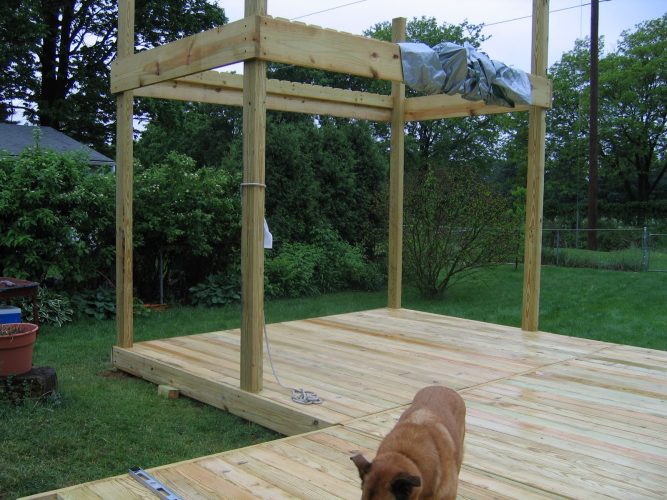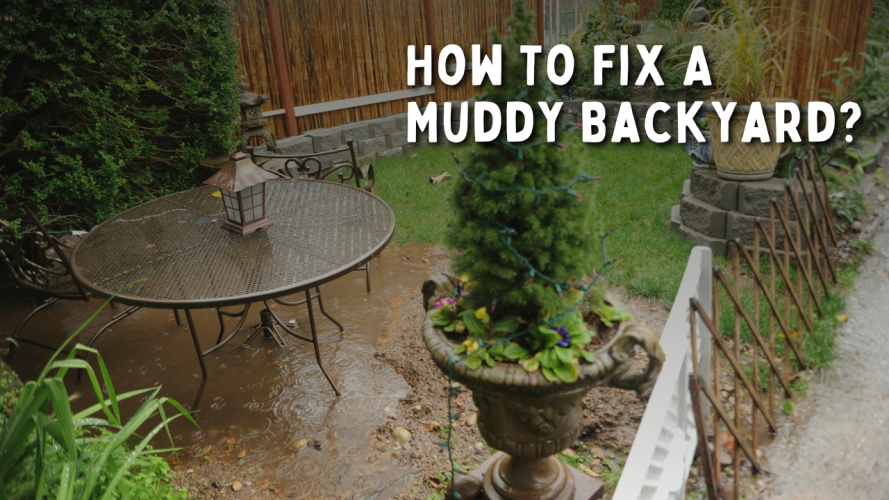How To Fix a Muddy Backyard?
A backyard can be a perfect place to relax and unwind. However, a muddy backyard can quickly turn your outdoor oasis into a mud pit.
Whether dealing with heavy rainfall, poor drainage, or overly compacted soil, a muddy backyard can be a frustrating and unsightly problem.
Fortunately, you can fix a muddy backyard in different ways and turn it into a beautiful, functional space that you can enjoy all year round.
What Causes a Muddy Backyard?
A muddy backyard can be a result of different things, such as the following:
Poor Drainage
One of the most common causes of a muddy backyard is poor drainage. When water can’t drain away from your yard properly, it can collect in low spots and form puddles, leading to muddy conditions.
Heavy Rainfall
Heavy rain can quickly saturate the soil and cause water to pool in your yard, resulting in muddy conditions. If your yard is particularly flat or needs better drainage, heavy rainfall can exacerbate the problem.
Foot Traffic
If you have a lot of foot traffic in your yard, particularly in a small area, the soil can become compacted and prevent water from draining properly. This can lead to muddy conditions, particularly after rain.
Pet Waste
If pets frequently use your yard, their waste can contribute to muddy conditions. Pet waste can break down the soil and prevent it from absorbing water properly, leading to mud.
Construction Work
If you’ve recently had construction work done in your yard, it can disrupt the natural drainage patterns and lead to muddy conditions.
Heavy machinery can compact the soil and prevent water from draining away properly while digging can disturb the soil and cause erosion.

Flickr Image by ConstructionDealMkting
How to Fix a Muddy Backyard?
If you’re dealing with a muddy backyard, you can take several steps to fix the problem and turn your outdoor space into a functional and beautiful area.
Here’s a list of solutions you can try:
Assess the Underlying Causes of the Problem
Before you can fix the problem, you need to understand what’s causing it. A muddy backyard can result from various factors, including poor drainage, compacted soil, or heavy rainfall.
Start by evaluating your backyard’s drainage system, slope, and soil type.
Determine if water is pooling in certain areas or if there are any low spots where water tends to accumulate. This will help you identify the root cause of the muddy backyard.
Improve Drainage
Improving your backyard’s drainage system is one of the most effective ways to fix a muddy backyard.
You can install a French drain or a dry well to redirect excess water away from your yard. Additionally, adding gutters to your roof and directing the downspouts away from your yard can help prevent excess water pooling in your backyard.
Another option is creating a rain garden to absorb and filter excess water.
Grade the Land
Grading your yard involves adjusting the slope of the land to allow water to flow away from your home and towards drainage areas.
This can be done by adding soil to create a slope or using heavy equipment to recontour the land. Grading can also help prevent erosion and create a more visually appealing landscape.
Use the Right Groundcover
Choosing the right ground cover can also help prevent a muddy backyard.
For example, planting grass or clover can help absorb excess water and prevent soil erosion. Additionally, mulch or wood chips can help improve soil structure and reduce erosion.
Create Pathways
Creating pathways can also help prevent a muddy backyard.
By creating a designated path for foot traffic, you can prevent people from walking through wet areas and compacting the soil. This can be done using gravel or stepping stones.
Install a Retaining Wall
If your backyard is sloped, installing a retaining wall can help prevent soil erosion and improve drainage. A retaining wall can be made of stone, brick, or concrete, adding function and beauty to your outdoor space.
Install a Rain Barrel
If you experience heavy rainfall, a rain barrel can help collect and store rainwater for later use.
This can help prevent excess water pooling in your yard and causing muddy conditions. Plus, you can use the collected rainwater to water your plants and garden.
Add Plants That Absorb Water
Some plants are better than others at absorbing excess water in your yard.
Plants with deep root systems, such as trees and shrubs, can help absorb water and prevent soil erosion. Additionally, plants native to your area better adapt to the local climate and soil conditions.
Build a Raised Bed
If you have a low spot in your yard that tends to collect water, building a raised bed can help.
Elevating the planting area can prevent the soil from becoming waterlogged and reduce the risk of soil erosion. Plus, a raised bed can add visual interest to your backyard.
Install Artificial Turf
Consider installing artificial turf if you’re tired of dealing with a muddy lawn. Synthetic grass can be a low-maintenance solution that looks and feels like real grass but doesn’t require watering or mowing. Plus, it can improve drainage and prevent soil erosion.
Install a Permeable Pavement
Consider installing permeable pavement if you have a driveway or patio that tends to get muddy.
Permeable pavements consist of porous materials, such as gravel or permeable concrete, that allow water to seep through and drain away, preventing puddles and mud.
Build a Deck or Patio
Consider building a deck or patio if you have a low spot in your yard that tends to collect water.

Flickr Image by Mary
Elevating the surface can prevent the soil from becoming waterlogged and reduce the risk of soil erosion. A deck or patio can be a functional and beautiful addition to your outdoor space.
In conclusion, a muddy backyard doesn’t have to be a problem.
By identifying the underlying causes of the issue and implementing simple solutions, you can transform your outdoor space into a functional and beautiful area.
Whether improving drainage, grading the land, or choosing the right ground cover, there are plenty of ways to fix a muddy backyard and create the oasis you’ve always wanted.
Closing Thoughts
A muddy backyard doesn’t have to be a headache.
By taking the time to assess the underlying causes of the problem and implementing some simple solutions, you can transform your backyard into a beautiful and usable space.
Possible permanent fixes include grading the land, improving drainage, choosing the right ground cover, etc.
So, roll up your sleeves, grab your gardening gloves, and get to work!

